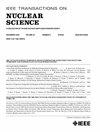Mechanisms of Dark Current Increase and Pixel Anomalies Induced by 2-GeV Ta-Irradiation in 8T-CMOS Image Sensors
IF 1.9
3区 工程技术
Q3 ENGINEERING, ELECTRICAL & ELECTRONIC
引用次数: 0
Abstract
The space optoelectronic imaging systems are susceptible to the impact of high-energy particle irradiation during on-orbit operations, leading to dark current increase and various types of pixel anomalies, which degrades device performance. Heavy ion and proton irradiation experiments on 8T-CMOS image sensors (CISs) are conducted to investigate the characteristics of dark current distributions and hot pixels. Additionally, cold pixels are observed in 8T-image sensors. The results demonstrate that dark current increases with increasing fluence, coupled with stopping and range of ions in matter (SRIM) simulations, Coulombic elastic scattering can be identified as the main cause for dark current increases due to proton and heavy ion irradiations, and the value of scattering cross sections may ultimately lead to offsets in the universal damage factor. A common exponential behavior is observed; integrating heavy ions into the existing theoretical framework, temperature dependence, and annealing of exponential behavior are also discussed. Both hot pixels and cold pixels can be attributed to defects induced by particle irradiation, with the difference that the defects causing hot pixels are located near the pinned photodiode, while the defects causing cold pixels are located in a specific capacitance of the 8T-CMOS image sensor.8T-CMOS 图像传感器中 2 GeV Ta 辐照诱发暗电流增加和像素异常的机制
空间光电成像系统在轨运行期间容易受到高能粒子辐照的影响,导致暗电流增加和各种类型的像素异常,从而降低器件性能。对 8T-CMOS 图像传感器(CIS)进行了重离子和质子辐照实验,以研究暗电流分布和热像素的特征。此外,还观察了 8T 图像传感器中的冷像素。结果表明,暗电流会随着通量的增加而增加,结合物质中离子的停止和范围(SRIM)模拟,可以确定库仑弹性散射是质子和重离子辐照导致暗电流增加的主要原因,而散射截面的值可能最终导致通用损伤因子的偏移。观察到一种常见的指数行为;还讨论了将重离子纳入现有理论框架、温度依赖性和指数行为退火等问题。热像素和冷像素都可归因于粒子辐照诱发的缺陷,不同之处在于导致热像素的缺陷位于引脚光电二极管附近,而导致冷像素的缺陷位于 8T-CMOS 图像传感器的特定电容中。
本文章由计算机程序翻译,如有差异,请以英文原文为准。
求助全文
约1分钟内获得全文
求助全文
来源期刊

IEEE Transactions on Nuclear Science
工程技术-工程:电子与电气
CiteScore
3.70
自引率
27.80%
发文量
314
审稿时长
6.2 months
期刊介绍:
The IEEE Transactions on Nuclear Science is a publication of the IEEE Nuclear and Plasma Sciences Society. It is viewed as the primary source of technical information in many of the areas it covers. As judged by JCR impact factor, TNS consistently ranks in the top five journals in the category of Nuclear Science & Technology. It has one of the higher immediacy indices, indicating that the information it publishes is viewed as timely, and has a relatively long citation half-life, indicating that the published information also is viewed as valuable for a number of years.
The IEEE Transactions on Nuclear Science is published bimonthly. Its scope includes all aspects of the theory and application of nuclear science and engineering. It focuses on instrumentation for the detection and measurement of ionizing radiation; particle accelerators and their controls; nuclear medicine and its application; effects of radiation on materials, components, and systems; reactor instrumentation and controls; and measurement of radiation in space.
 求助内容:
求助内容: 应助结果提醒方式:
应助结果提醒方式:


